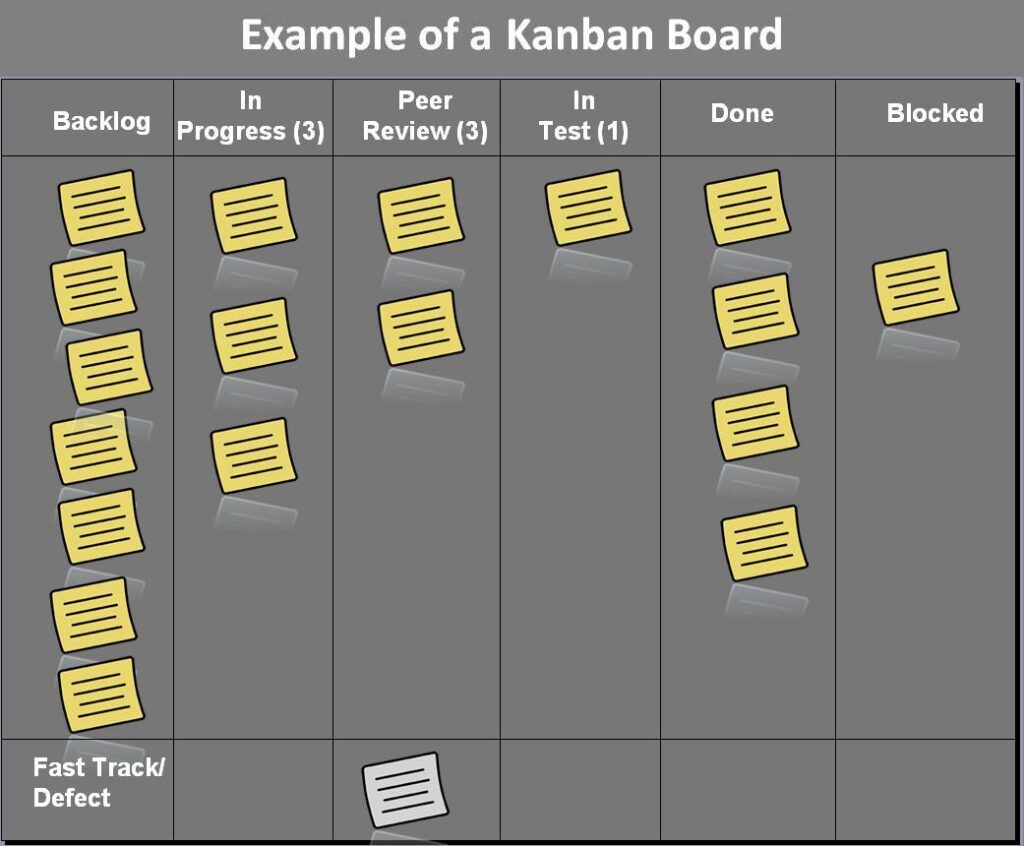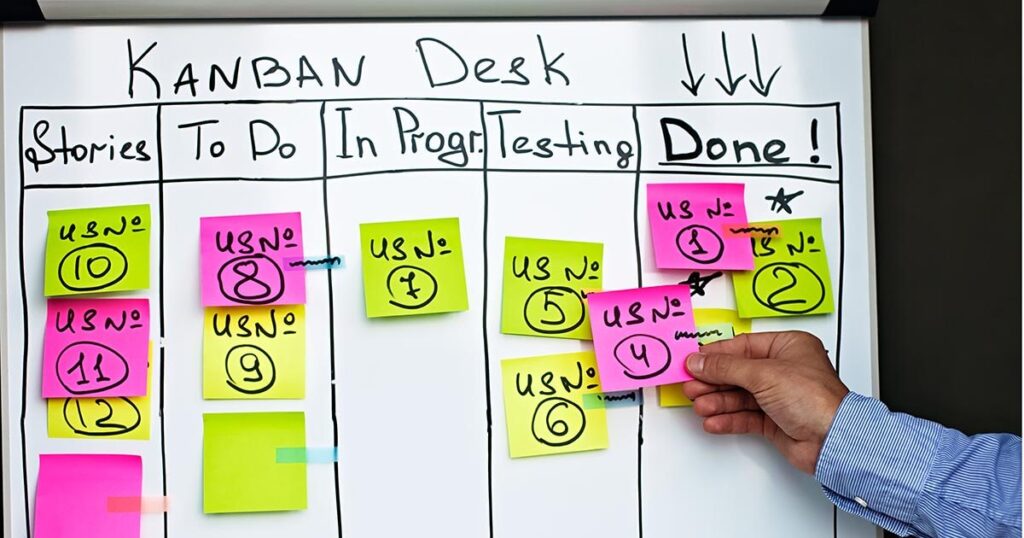Have you ever wondered what Kanban is all about?
You are right on track. This article breaks down Kanban to provide you with deep insight into how teams incorporate it into project management.
Kanban is a visual system for managing work as it moves through a process. Kanban visualizes both the process and the actual work passing through that process. The goal of Kanban is to identify potential blockages in your process and fix them. That way, teams find it easier to execute more cost-effective and optimal workflows.
To learn more via video, watch below. Otherwise, skip ahead.
What is Kanban?
Kanban is a Japanese word meaning “visual board” or “sign”. Being relative to lean and just-in-time (JIT) production, Kanban is a concept that teams have used as a process definition since the early 1960s. As a workflow management method, it defines, manages, and improves a variety of services whilst maximizing efficiency and improving work output.

Credits: Wikipedia
Kanban started as a scheduling system for lean production organizations and originated from the Toyota Production System (TPS). Toyota introduced “just in time” manufacturing to its production in the late 1940s as a pull system where production revolved around customer demand.
In this approach, the idea is to carry production based on customer demand rather than the usual practice that involves producing goods in numbers and pushing them out to the market.
This unique system of production brought the Lean system of manufacturing which works to minimize all forms of waste activities while enhancing productivity at all levels. The main goal is to create more value for the customer without generating more costs.
Overview of the Kanban Method
The lean manufacturing process seen in Kanban thus got its basis from the “just in time” manufacturing. This approach minimizes waste without having to sacrifice productivity, thus creating better value for the customer without generating more internal costs.
With the advancement of technology, teams across a wide range of commercial sectors have embraced Kanban. The interesting thing about Kanban is that its applicable to any and every situation, provided the team puts in place the appropriate implementation means.
A standard Kanban board has 3 columns; “requested”, “in progress” and “done”. Constructing and managing your Kanban board offers the benefits of it serving as a real-time data depository that highlights any difficulties that emerge within the system. It also prevents random inadequacies that interrupt the smooth running of your project and working practices.
How do Teams Implement Kanban?
For a successful implementation of the Kanban method, it is important to get practical. The process involves 6 strategic steps that teams must understand. You also need to know that Kanban is an evolving process; it is dynamic and adapts relative to the current state of the business environment.
Let’s take a look at these 6 core practices of Kanban that work together for successful implementation:
Visualize the Workflow
First thing, you need to visualize the processes that you use to deliver your work or your services either on a physical board or an electronic Kanban Board. To do this, you need a board, cards, and columns.

Credits: Ionos
The columns represent a step in your workflow while each of the cards represents a work item. The kanban board as a whole is a typical representation of your workflow, inclusive of its specifications and risks involved. Getting to know how your system works from a visual perspective gives you a clear idea of areas where you need to improve and make effective changes. When you have started carrying out an outlined project, then proceed to pull the item from the “to do” column, and when you complete it, then transfer it across to the “done” section. This is a good way to track how progressive your projects are as well as identify any form of backlog affecting your production line.
Limit Work in Progress (WIP)
As part of its functions, Kanban ensures that only a feasible number of active items are progressive at any particular time. Limiting work-in-progress creates capacity in the system to help you start a new task instead of multitasking which results in wastage and inefficiency.
This process of limiting the work in progress enables you or your team members to work at hand first before taking up new work. This encourages you to stay focused on the current project. When you’ve completed it, mark it as ‘done’ and move on to the next. On your Kanban board, implement a pull system on parts of the workflow. This means that you set a maximum number of items per stage to ensure that a card is only “pulled” into the next step when there is available capacity. Limiting work in progress is also effective in communicating with your customers and other stakeholders that there is limited capacity to do work for any team. Thus, the need to properly strategize on the kind of work they ask the team to do.
Manage Flow
Managing your flow simply refers to monitoring the movement of work items through the production process to ensure everything moves at a predictable and sustainable pace. Kanban is an effective way to manage your work system by highlighting the various stages of the workflow and making adjustments to improve flow to reduce the time it takes to complete each piece of work. This helps you create a lot of value easier and faster.
Rather than clouding team members with so much work without much productivity, managing your workflow is a sure way to create a better understanding of the work practices and how to get that work faster through the system. While you strive to improve your team’s workflow, work delivery by team members becomes clearer and much easier. This makes it possible for you to make reliable commitments to your customers regarding the status and progress of any task.
Make Process Policies Explicit
It is important to explicitly outline your work goals, policies, and means of implementation in such a way that they are easy to understand and execute. Kanban is relevant in this scenario as it guarantees that your team defines, manages, and executes on processes within a system. When your goals are clear and relatable, team members feel encouraged to participate, share ideas, and work together to enhance productivity and promote your brand in different ways.
Feedback Loops
Feedback loops are crucial for any working system. Achieving continuous improvement and sustainable change depends on how well team members identify loopholes. With the aid of the Kanban method, implementing feedback loops becomes so much easier and feasible. Implementing feedback loops is a crucial step for teams that want to grow and remain on top of the game.
Feedback loops promote positive dynamism and ensure your team responds to changes. Kanban suggests the use of feedback loops at a team level to help understand the reason for backlogs in a working system. This is a considerable step towards promoting continuous improvement of your network of services.
Improve Collaboratively
The Kanban Method is a effective one for continuous improvement. It provides adequate mechanisms for evaluating team and organizational performance to determine if your work systems are improving. As an evolutionary development process with a scientific approach, Kanban enables you to form a hypothesis, test it and make changes depending on the result of your test.
The measure of the changes you make corresponds to the various signals your Kanban system provides you. These signals help you to determine whether the changes you make have a positive impact on your work system or whether there is a need to adopt new innovative strategies. Kanban allows you to gather a substantial amount of your system’s performance data.
Start Using Kanban Today
The Kanban method works for all kinds of lean businesses interested in cutting down costs and wastage without any negative impact on the quality of their products or their standard of customer service.
Prominent businesses such as Pixar, Spotify, Zara, and many others have implemented the Kanban method to execute projects, improve performance and exceed their goals.
Consider using Kanban in your team management efforts today to increase your team’s chances of nailing its goals and objectives.
